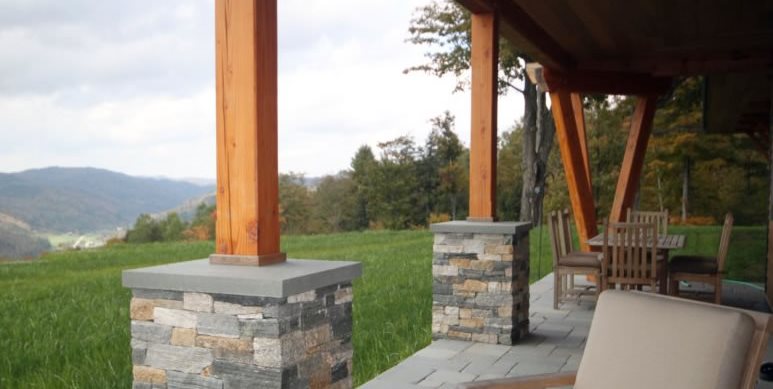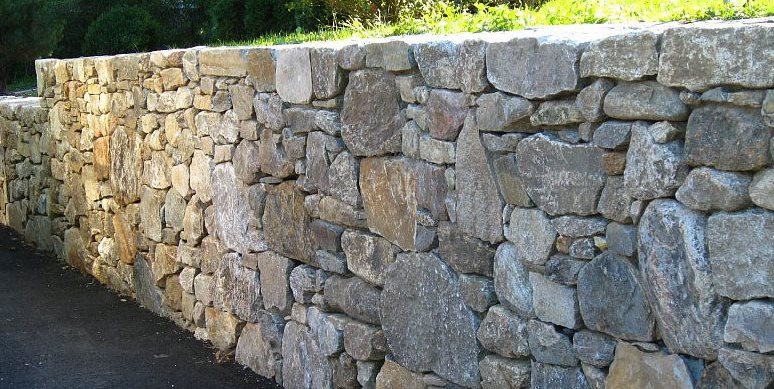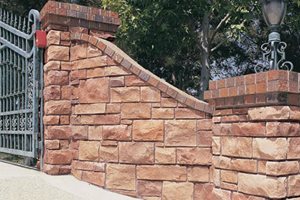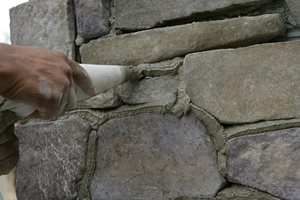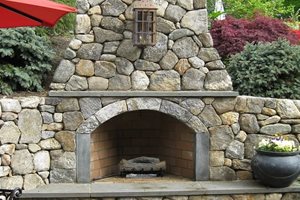Stone Veneer Cost
Material and labor cost considerations for installing stone veneerWhen evaluating the cost of stone veneer, there are two primary factors in this equation: labor and materials. However, stone veneer was itself invented as a means of lowering both labor and material costs compared to traditional stonework. Therefore the nuances of construction may be all that separates one veneer choice from the next.
David Croteau of Stoneyard.com ships his natural stone veneers nationwide and does a very strong local business in Massachusetts and New England. He explains the subtle variations of cost estimating.
"On the east coast cost of material is a third, labor is about two thirds. Labor is high because the hand work of putting it together is expensive. In the South, Midwest and West, the labor pricing comes down considerably and I don't really know why. It may be due to the fact that weather is more seasonable there so they can work outdoors more of the year."
- Pro Tip: Transportation of thin veneer is 1/4 the weight of more traditional building veneer, which makes it inexpensive to ship across country. We even ship to Alaska, but again, you only ship a quarter of the weight. --David Croteau, Stoneyard.com
"There's a range of raw material prices but most fall between $10 and $20 per square foot with $15 the average. There are other manufacturing aspects that affect our pricing. Ashlars, square and rectangle veneer is our top price because they require a lot of trimming and there's considerable waste. The scraps left over from those patterns go into our ledgestone. Mosaic uses a natural shape so it's lower too, but in the field it requires a lot of shaping which drives up the cost of installation for skilled masons. While ledgestone is cheapest for us to produce, installation costs are highest because in one square foot you must hand set 6 to 7 smaller stones. Other patterns may require setting just two or three pieces per square foot, so the amount of trimming added to pieces per square foot equals labor cost factors. That's why you have a strong link between some patterns and higher installation costs so comparing labor and materials separately may not give the whole picture.
| Veneer Pattern | Material Cost | Installation Cost |
|---|---|---|
|
Ashlar |
High - requires a lot of trimming during the manufacturing process, produces waste |
Low - little cutting needed on the job site, large pieces install quickly |
|
Square |
High - requires a lot of trimming during the manufacturing process, produces waste |
Low - little cutting needed on the job site, large pieces install quickly |
|
Rectangle |
High - requires a lot of trimming during the manufacturing process, produces waste |
Low - little cutting needed on the job site, large pieces install quickly |
|
Ledgestone |
Low - uses scraps from Ashlar, square and rectangle paterns, no trimming required during manufacturing |
High - A lot of cutting may be necessary on the job site, small pieces install slowly |
|
Mosaic |
Low - uses scraps from Ashlar, square and rectangle paterns, no trimming required during manufacturing |
High - A lot of cutting may be necessary on the job site, small pieces install slowly |
This illustrates why veneer panels are so important in some applications and for ledgestone to bring down high labor costs. Many parts of the country do not support a labor pool of skilled stone masons as there are in traditional regions of stone construction such as the Northeast. That means that contractors will shy away from veneer options that demand especially skilled labor. They'll tend toward the types of veneers that can be installed by low end labor accustomed to laying simple concrete block walls or brick edging. These are the markets where manufactured stone and panels become a larger part of landscape construction because they eliminate the need for a landscape contractor to find a skilled stone mason to do specialty work. High end firms that are heavy on custom natural stonework may retain a mason year around, but unless there's sufficient numbers of natural stone projects available to a contractor, they may be forced to subcontract the work out at a cost that's passed along to the customer.
Mortar or Drystack
Drystack is a term used to install stone veneers without visible mortar in between each stone. The popularity of ledgestone, a tightly packed layered effect was inspired by cliff dwellings of the American Southwest where mortar was not used by Native Americans.
A second tradition goes back to dry laid stone walls of New England. David Croteau of Stoneyard.com has a hands-on knowledge of this regional style. "If you have a maintenance issue it's about the cement, so people think if you do away with it there won't be so much maintenance. They don't realize it takes a lot more skill and trim to make it fit together. Today we can create dry stone look with thin veneer. There are some cements that take the freeze thaw but it's a lot of different factors that make it work properly. Drystack highlights stone, and a lot of people are attracted to that look. When you look around at other companies I don't see as much dry laid. Ours look like dry laid but they're not. We know dry laid gets a big interest and we know it takes skilled masons to do it. Here in the northeast, I believe it reaches back to the old dry laid stone walls," says David.
When ledgestone or any other kind of stone veneer is applied without mortar, the cost will be lower because a whole step (applying mortar) is eliminated. There will be mortar used, however, but it is hidden at the back of the veneer where it intersects the masonry or frame wall.
The drystack look is growing in popularity and is now seen in many other veneer patterns. While the costs may appear lower, there are unseen differences that can make this choice more expensive or problematic in the future. In fact, the savings due to absence of mortar may be offset by increased labor required for non-ledgestone patterns. Without mortar, each stone must fit tightly against the next, so every piece must be hand trimmed prior to setting. Such precision work requires an experienced stone mason, which can increase costs significantly.
Mortar is used in masonry to prevent water from seeping into the wall through the spaces between stones. It also helps to keep each piece of stone securely in place. As a result, the problems with dry stack relate to the absence of mortar. Water can more easily work its way into the joints between stones to accumulate behind them. There it can freeze and expand to debond the veneer stones or cause them to crack. Therefore careful waterproofing is recommended, which may add even more invisible cost.

 Backyards
Backyards
 Front Yards
Front Yards
